If you experience water damage in your home during the winter, it can be a stressful and overwhelming situation. However, taking prompt and appropriate action can help minimize the damage and get your home back to normal as quickly as possible. Here are some steps to follow if you experience water damage in the winter:
- Shut off the water source: If you can locate the source of the water, such as a burst pipe, shut it off immediately. This will help prevent further water damage to your home.
- Remove standing water: If there is standing water in your home, use a wet/dry vacuum or mop and bucket to remove as much water as possible. Be sure to wear protective clothing, such as rubber gloves and boots, when handling water.
- Dry out the affected area: Use fans, dehumidifiers, and heaters to help dry out the affected area. If the humidity is low outside, you can also open windows and doors to help dry out the space.
- Monitor for mold growth: Water damage can lead to mold growth, which can be harmful to your health. Keep an eye out for any signs of mold, such as a musty smell or discoloration on walls and surfaces. If you do find mold, it is important to have it professionally removed.
- Document the damage: Take photos and video of the damage for your insurance company. Keep receipts for any repairs or replacements you make.
- Contact your insurance company: If you have homeowner’s insurance, contact your insurance company to report the water damage. They will be able to advise you on the next steps and may send an adjuster to assess the damage.
- Repair the source of the water damage: If the water damage was caused by a burst pipe, it will need to be repaired or replaced to prevent further damage. If the damage was caused by something like a leaky roof, it will also need to be repaired.
By following these steps, you can help minimize the damage and get your home back to normal as quickly as possible. Remember to stay safe and take all necessary precautions when handling water damage in the winter.



